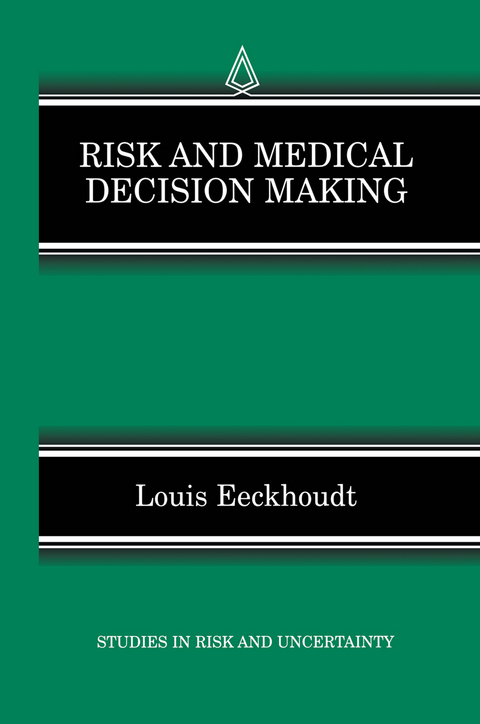
Risk and Medical Decision Making
Seiten
2002
Springer-Verlag New York Inc.
978-1-4020-7007-5 (ISBN)
Springer-Verlag New York Inc.
978-1-4020-7007-5 (ISBN)
For people interested in risk management, medical activity represents a stimulating field of study and thought.
In Risk and Medical Decision Making, part 1 is developed inside the expected utility (E-U) model and analyses how comorbidity risks affect the well-known "test-treatment" thresholds.
For people interested in risk management, medical activity represents a stimulating field of study and thought. On the one hand, progress in medical knowledge and technology tends to reduce the risks to survival that individuals would face in the absence of appropriate diagnostic or therapeutic instruments. On the other hand, new medical technologies simultaneously create their own specific risks, sometimes simply because their effects are less well-known than those of established ones. In a sense any medical progress simultaneously generates new risks while destroying old ones. Moreover, unlike many financial risks that can be either divided or transferred to others (e.g. through diversification, insurance or social security) the personal aspects of medical risks are by essence indivisible and non-transferable. As a result, they are in a sense more threatening than financial risks for risk averse patients. These two facts explain and justify the growing interest in risk economics for the fields of medical decision making and health economics.
In Risk and Medical Decision Making, part 1 is developed inside the expected utility (E-U) model and analyses how comorbidity risks affect the well-known "test-treatment" thresholds. Part 2 is devoted to a specific non E-U model with the same purpose: how would one define a threshold in this context and how would one value a diagnostic test? In each of these two parts both diagnostic and therapeutic risks are considered.
In Risk and Medical Decision Making, part 1 is developed inside the expected utility (E-U) model and analyses how comorbidity risks affect the well-known "test-treatment" thresholds.
For people interested in risk management, medical activity represents a stimulating field of study and thought. On the one hand, progress in medical knowledge and technology tends to reduce the risks to survival that individuals would face in the absence of appropriate diagnostic or therapeutic instruments. On the other hand, new medical technologies simultaneously create their own specific risks, sometimes simply because their effects are less well-known than those of established ones. In a sense any medical progress simultaneously generates new risks while destroying old ones. Moreover, unlike many financial risks that can be either divided or transferred to others (e.g. through diversification, insurance or social security) the personal aspects of medical risks are by essence indivisible and non-transferable. As a result, they are in a sense more threatening than financial risks for risk averse patients. These two facts explain and justify the growing interest in risk economics for the fields of medical decision making and health economics.
In Risk and Medical Decision Making, part 1 is developed inside the expected utility (E-U) model and analyses how comorbidity risks affect the well-known "test-treatment" thresholds. Part 2 is devoted to a specific non E-U model with the same purpose: how would one define a threshold in this context and how would one value a diagnostic test? In each of these two parts both diagnostic and therapeutic risks are considered.
1: Introduction.- 1: Developments inside the E-U model.- 2: The case of diagnostic risks in a single risk environment.- 3: The introduction of “comorbidity risks” and the treatment threshold. The notion of prudence.- 4: Treatment decisions under therapeutic risks.- 5: The value of diagnostic tests (under risk neutrality).- 6: Risk aversion and diagnostic tests.- 7: Comorbidity risks and the value of a test: a short overview.- 2: M.D.M and new models of choice under risk.- 8: Treatment thresholds and the dual theory of choice under risk.- 9: Diagnostic tests and the dual theory.- Conclusions.- References.
| Reihe/Serie | Studies in Risk and Uncertainty ; 14 |
|---|---|
| Zusatzinfo | V, 135 p. |
| Verlagsort | New York, NY |
| Sprache | englisch |
| Maße | 155 x 235 mm |
| Themenwelt | Wirtschaft ► Betriebswirtschaft / Management ► Finanzierung |
| Betriebswirtschaft / Management ► Spezielle Betriebswirtschaftslehre ► Versicherungsbetriebslehre | |
| Wirtschaft ► Volkswirtschaftslehre ► Mikroökonomie | |
| ISBN-10 | 1-4020-7007-1 / 1402070071 |
| ISBN-13 | 978-1-4020-7007-5 / 9781402070075 |
| Zustand | Neuware |
| Haben Sie eine Frage zum Produkt? |
Mehr entdecken
aus dem Bereich
aus dem Bereich
Bedarfsanalyse, Vertrags-Check, Testsieger für jede Situation, …
Buch | Softcover (2024)
Stiftung Warentest (Verlag)
CHF 20,95


